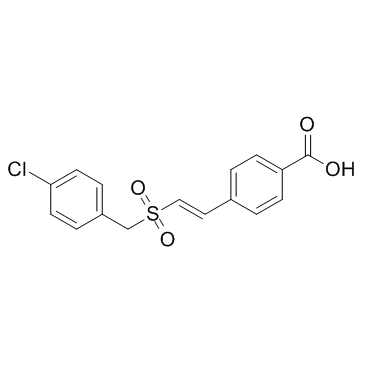334969-03-8
| Name | (E)-4-(2-((4-chlorobenzyl)sulfonyl)vinyl)benzoic acid |
|---|---|
| Synonyms |
4-((1E)-2-{[(4-chlorophenyl)methyl]sulfonyl}vinyl)-benzoic acid
(E)-4-carboxystyryl 4-chlorobenzyl sulfone ON 01210 4-chlorobenzyl-4-carboxystyryl sulfone 4-carboxystyryl-4-chlorobenzylsulfone (E)-4-carboxystyryl-4-chlorobenzylsulfone Recilisib sodium Recilisib 4-((E)-2-(4-chlorobenzylsulfonyl)vinyl)benzoic acid |
| Description | Recilisib is a radioprotectant, which can activate AKT, PI3K activities in cells. |
|---|---|
| Related Catalog | |
| Target |
Akt PI3K |
| In Vitro | Recilisib Sodium (up to 50 µM) shows a normal distribution of cells throughout the cell cycle, with a slight reduction in the number of cells in S-phase at 50 µM. Continuous exposure of Recilisib Sodium (100 µM) does not result in cell death. Recilisib Sodium does not inhibit the ability of human bone marrow to form colonies in methylcellulose at either timepoint. Recilisib Sodium treatment does not inhibit the colony forming potential of human bone marrow cells. Recilisib Sodium provides dose dependent protection of human bone marrow cells at all three doses of IR. Recilisib Sodium activates the phosphorylation of AKT and GSK3α/β in HFL cells. Recilisib Sodium increases PI3K activity in HFL-1 cells and murine bone marrow cells in response to radiation exposure. Recilisib Sodium treatment in combination with radiation alters the MAPK signaling pathway[1]. |
| In Vivo | Recilisib Sodium (500 mg/kg) significantly increases the rate of recovery and differentiation of primitive bone marrow myeloid progenitor cells in mice. Recilisib Sodium in combination with radiation reduces CFU numbers in mice, but the Recilisib Sodium-treated mice consistently retain a capability to form differentiated colonies. Recilisib Sodium treated mice have a progenitor cell population that is never completely depleted by radiation exposure[1]. |
| Kinase Assay | PI3-kinase assays are performed using exponentially growing HFL-1 or freshly harvested murine bone marrow cells that are treated with increasing concentrations of Recilisib Sodium for 2 hours and then irradiated with 10 Gy IR. These cells are then returned to the incubator for 2 to 24 hours and lysed in HEPES pH 7.5 lysis buffer. PI-3K is immunoprecipitated using an anti-PI3 Kinas polyclonal antibody for 2 hours at 4°C. Protein A/G PLUS-Agarose is incubated with immunoprecipitates for 8-16 hours at 4°C and the resulting immunoprecipitates washed with twice HEPES pH 7.5 lysis buffer and once with the kinase buffer (20 mM Tris pH 7.5, 1mM EGTA, 10mM MgCl2, 2 mM DTT, 0.01% NP-40). L-α-Phosphatidylinositol (12.5 mM) and ATP (10 µM) are added to the kinase buffer (60 µL per sample) and incubated at 30°C for 30 minutes. The reaction is stopped by addition of 100 µL of 1N HCl and extracted by addition of 200 µL CHCl3/CH3OH (1:1). The extracted samples are vortexed, centrifuged and the lower organic phases containing phospholipids are dried at 27°C for 2 hours. The dried samples are resuspended in 10 µL of PI-4-P standard (0.5 mL CHCl3, 0.5 mL CH3OH, 2.5 µL HCl) and spotted on TLC plates (VWR). The spotted plate is subjected to thin layer chromatography in CHCl3/CH3OH/NH4OH (40:40:15). The TLC plate is dried and subjected to autoradiography. |
| Cell Assay | For cytotoxicity assays, cells (1.0×105 cells/mL HPGM) are treated with various concentrations of Recilisib Sodium or vehicle without radiation treatment for 2 or 24 hours. The cells are washed and plated into methocult using gridded dishes. The total number of colony forming units (CFUs) is determined 14 days post-plating by microscopic observation using an Olympus IMT-2 microscope. |
| References |
| Density | 1.4±0.1 g/cm3 |
|---|---|
| Boiling Point | 607.8±55.0 °C at 760 mmHg |
| Molecular Formula | C16H13ClO4S |
| Molecular Weight | 336.79000 |
| Flash Point | 321.4±31.5 °C |
| Exact Mass | 336.02200 |
| PSA | 79.82000 |
| LogP | 3.84 |
| Vapour Pressure | 0.0±1.8 mmHg at 25°C |
| Index of Refraction | 1.639 |
| Storage condition | 2-8℃ |
